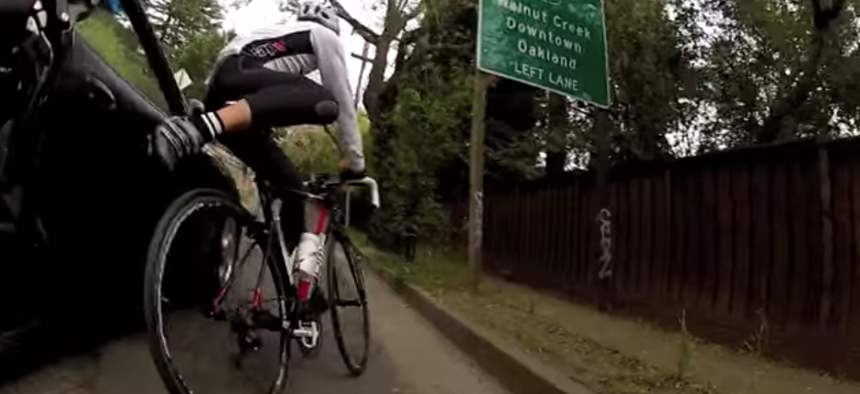Considering Ways to Prevent America's Deadliest Type of Bike Crash

A cyclist is hit by a car in California. YouTube

Connecting state and local government leaders
"Overtaking" crashes have led to more than 600 cyclist fatalities in recent years.
Crashes involving motorists passing bicyclists were the leading cause of cyclist deaths on America’s roadways in recent years.
These types of incidents killed at least 675 of the roughly 2,400 people who died in bicycle crashes between 2014 and 2016, according to federal data cited during a presentation this week. The passing incidents can occur when a driver strikes a bicyclist from behind, or passes too closely causing the cyclist to lose control.
On Monday, the Pedestrian and Bicycle Information Center held an online seminar where experts discussed some of the factors involved in these passing, or “overtaking,” crashes and different types of policies and street design features that might help to prevent them.
Libby Thomas, senior research associate at the University of North Carolina Highway Safety Research Center, presented the crash data. She noted that, of the fatal overtaking crashes, 397 were in urban areas, and 264 in rural areas. The share of rural crashes that involved vehicles passing cyclists was high compared to the urban figures—38 percent versus 24 percent.
A majority of overtaking collisions, Thomas said, happen on higher-speed roads, at night or in low light, and about a quarter involve hit-and-run drivers. Most cyclists, about 80 percent, were riding in a shared lane with traffic just before they crashed.
Bill Schultheiss, vice president and director of sustainable safety for Toole Design Group, also spoke during the seminar.
“I think the problem is the money it's going to take to retrofit a system that was improperly built to be safe for people to make mistakes,” he said.
Schultheiss offered some insight into how forthcoming bicycle infrastructure guidance from the American Association of State Highway and Transportation Officials is taking shape. The guidance, Schultheiss said, is expected out in late 2019, pending further review and approval.
He noted that there is a transition taking place in how the transportation planning and engineering community is thinking about bicycle infrastructure, and the end-users it is built for.
“Historically, the design user in prior AASHTO guidance, has been a rather confident adult male cyclist,” he said. “It’s going to shift.”
That shift, Schultheiss said, will be geared toward designing cycling infrastructure that a larger percentage of the population wants to use, and feels safe using.
Ken McLeod is policy director for the League of American Bicyclists, a group that has developed model legislation for “safe passing laws,” which typically establish a safe distance for motorists to keep from bicyclists when passing them. That has often been set at at least 3 feet.
Thirty-five states have now adopted safe passing laws in line with the League of American Bicyclists' standards, McLeod said Monday. Another 15 states do not have these sorts of laws in place.
“Passing laws have really taken off over the last decade, decade and a half,” McLeod said.
But he also explained that it can be difficult to implement safe passing laws, and that there is limited information on how the laws are being enforced and whether they are actually improving safety.
“We’re still building that evidence base,” he said.
On the design side, Schultheiss offered the view that it is “really inappropriate” to mix cyclists in with trucks and other vehicles that are much larger, and traveling faster than they are. He also emphasized that safe bicycle infrastructure can vary based on the speed that vehicles are traveling and the traffic volume on a roadway.
Motor vehicles and bikes might be able to safely share a lane on a quiet side street.
On the other hand, a busy road in a city or suburb might require a clearly demarcated or separated bike lane to be safe, offering greater predictability for drivers and cyclists about where they will both be traveling on the roadway and more leeway for them to make errors.
Designing streets to accommodate cyclists at night was another issue that Schultheiss raised.
There are also questions about when it makes sense to build pathways where bicycles and pedestrians mix. In places where trail use gets too high, these mixed pathways can lead to conflicts and safety hazards between cyclists and people on foot.
Schultheiss said a problem he sees with shared-use pathways is that they’ve frequently been "under-designed" and don’t take into account that when many people walk or bike they do so traveling side-by-side.
Likewise, designing on-street bike lanes to minimum widths provides little room for mistakes by drivers or bicyclists and can make it difficult for cyclists to safely pass one another.
For rural areas, widening road shoulders can be a way to improve the safety and comfort level of cyclists, according to Schultheiss. In places with tight budgets, targeted upgrades, like widening a shoulder on a blind curve or hill, can be an option. Wider lane stripes can help, too. So can side-paths between parks, towns and other destinations.
Schultheiss said that research has consistently shown since the 1970s that both bicyclists and motorists prefer separation between them, that bike lanes are safer than shared lanes, and that bicyclist crash risks increases when cyclists are riding in the opposite direction of traffic.
Bill Lucia is a Senior Reporter for Government Executive's Route Fifty and is based in Washington, D.C.

NEXT STORY: Dangerous Gases in Dayton’s Sewers





